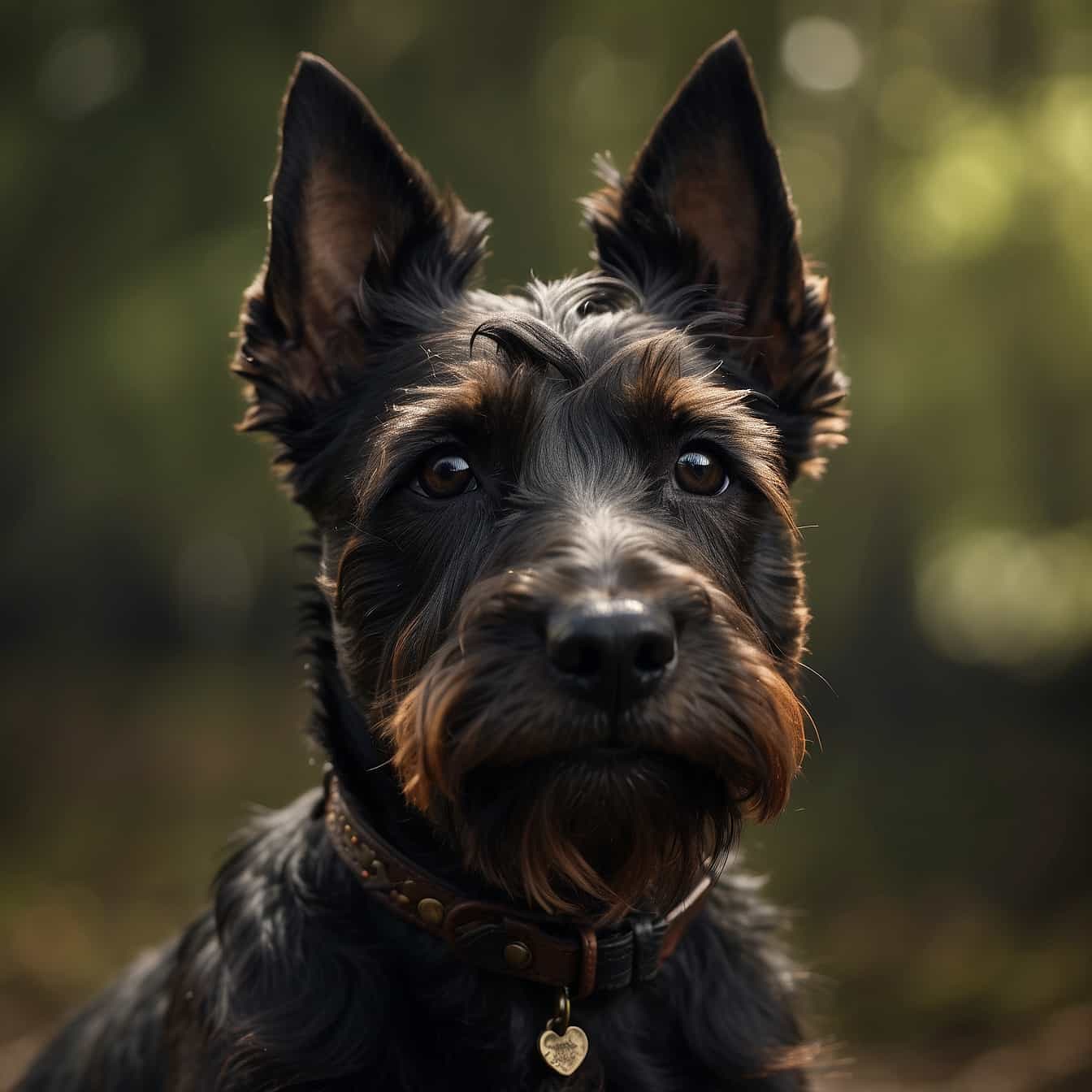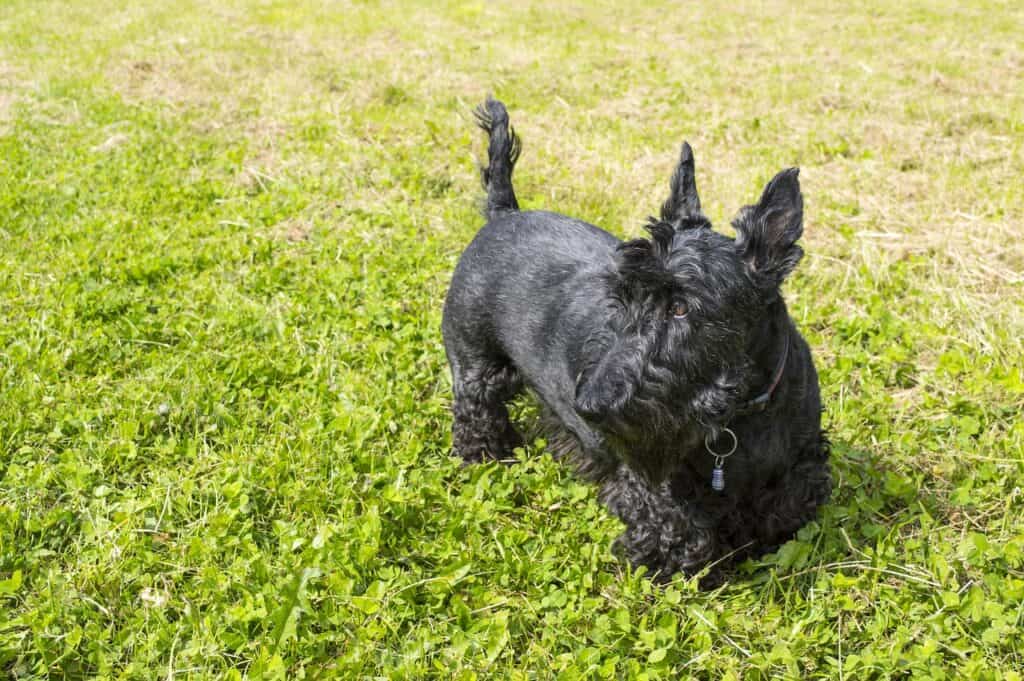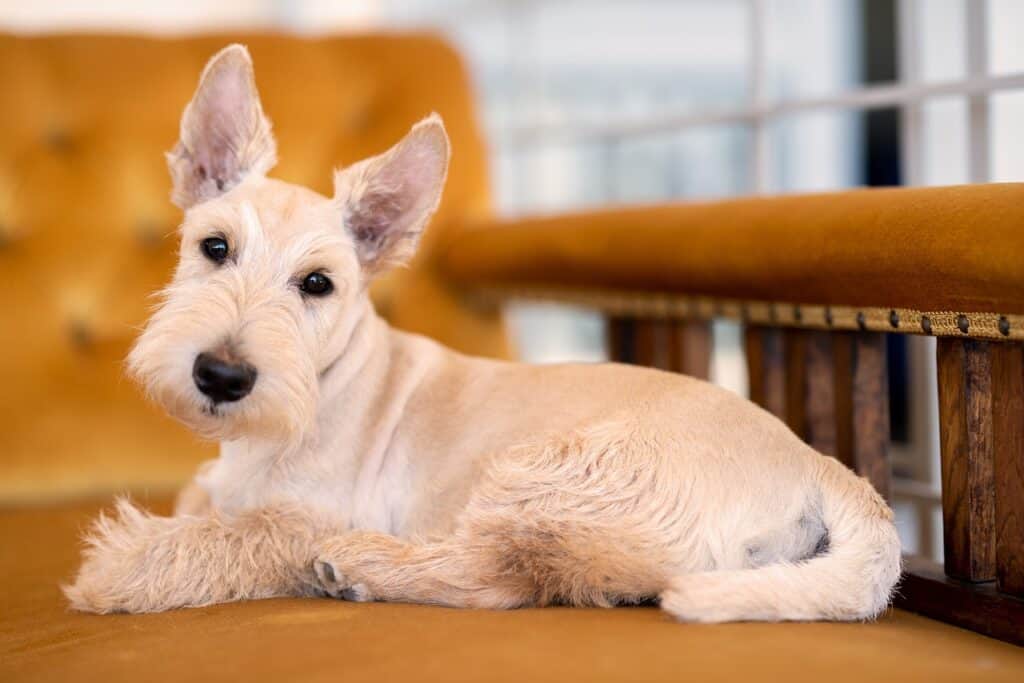Prepare to be captivated by the timeless charm of Scottish Terriers, often known as Scotties. These dignified and iconic dogs have a history that spans centuries. Uncover their distinctive characteristics, their independent nature, and their undying loyalty, which has earned them a special place in the hearts of many.

| Category (Explanation) | Breed Information |
|---|---|
| Year of Breed Conception | 1800s |
| Country of Origin | Scotland |
| Weight (lbs & kg) (Male) | 19-22 lbs (8.5-10 kg) |
| Weight (lbs & kg) (Female) | 18-21 lbs (8-9.5 kg) |
| Coat Type | Dense, wiry outer coat and soft undercoat |
| Color Variations | Black, wheaten, or brindle |
| Shedding Level (Low, Moderate, High) | Low |
| Height (cm & in) | 10 inches (25 cm) and under |
| Breed Size | Small |
| Trainability (Low, Moderate, High) | Moderate |
| Mental Needs (Low, Moderate, High) | Moderate |
| Intelligence Level (Low, Moderate, High) | High |
| Energy Level (Low, Moderate, High) | Moderate |
| Agility (Low, Moderate, High) | Moderate |
| Loyalty (Low, Moderate, High) | High |
| Playfulness (Low, Moderate, High) | Moderate |
| Exercise Needs | Regular exercise and mental stimulation |
| Guarding Proficiency (Low, Moderate, High) | Moderate |
| Sociability with Children (Low, Moderate, High) | Moderate |
| Barking Level (Low, Moderate, High) | Moderate |
| Digging Tendency (Low, Moderate, High) | Moderate |
| Destructive Behavior (Low, Moderate, High) | Moderate |
| Drooling Level (Low, Moderate, High) | Low |
| Obedience Level (Low, Moderate, High) | Moderate |
| Apartment Friendly (Yes/No) | Yes |
| Inherent Prey Drive | Moderate |
| Physical Risk to Others (Low, Moderate, High) | Low |
| Travel Fatality Risk (Low, Moderate, High) | Low |
| Allergen Potential | Low |
| Health Concerns (List of Common Health Concerns) | Scottie Cramp, Von Willebrand's Disease |
| Average Life Expectancy (Life Expectancy in Years) | 11-13 years |
Woof Mastery is reader supported and our articles may contain affiliate links.
Instead of running third party ads that we have no control of we only use links from high-quality companies we are directly partnered with. Making use of these links come at no cost to you our reader, and in many cases have the extra benefit of discounted rates or sign up bonuses.
If you’re interested you can read more about our affiliate policy here.
We appreciate your support and always insure that the products and services we recommend are high-quality, helpful and relevant to the subject at hand!
The Scottish Terrier, often called the Scottie, has a history steeped in timelessness. Originating in Scotland, they were bred to hunt vermin and small game. Their distinctive appearance, including a wiry coat and upright ears, has been a constant feature for centuries. The Scottie’s dignified and independent nature made them a symbol of Scottish pride. Over the years, they became popular pets of famous figures, including Presidents Franklin D. Roosevelt and George W. Bush. The loyalty and timeless charm of Scotties have made them a beloved breed that captures the hearts of dog enthusiasts worldwide.

The Scottish Terrier, or Scottie, is special for its timeless charm, dignified demeanor, and unwavering loyalty. These iconic dogs have a history that spans centuries, making them a cherished breed. Their independent nature and distinctive characteristics set them apart, and their special place in the hearts of many is a testament to their exceptional qualities.
Scottish Terriers, commonly known as Scotties, have a rich history rooted in Scotland. Their traditional role traces back to their origins in the Highlands, where they were used for hunting small game, including rats, foxes, and badgers. Their distinctive appearance and fearless demeanor made them ideal for these tasks. Scotties’ loyalty and tenacity earned them a place as reliable working dogs in the Scottish countryside. Today, they are cherished family pets, but their historical role as hunters and guardians of homesteads is a testament to their enduring spirit.
Scottish Terriers, or Scotties, are characterized by their dignified and independent personalities. They have a strong sense of loyalty to their families and are known for their charming and timeless charm. These terriers may be reserved with strangers but are incredibly loyal to those they love. With a bit of stubbornness and a lot of love, they make devoted and distinctive companions.
Scottish Terriers are dignified and loyal dogs. They are typically independent and have a strong sense of self. While they can be affectionate with their families, they may exhibit territorial behavior and can be reserved with strangers. Early socialization can help them become more welcoming to new people and situations.
Scottish Terriers, or Scotties, are compact, sturdy dogs with a dignified appearance. They have a wiry, weather-resistant double coat that comes in shades of black, wheaten, or brindle. Scotties have a distinctive beard and bushy eyebrows that frame their expressive, dark eyes. Their ears are small and erect, and their tail is short and carried erect. The Scottie’s body is well-muscled and their legs are straight and strong. They have a dignified and confident gait, which adds to their regal presence.
Scottish Terriers, or Scotties, are known for their solid black, brindle, or wheaten (wheat-colored) coats. The black coat is one of the most iconic, but brindle (a mix of dark and light stripes) and wheaten (a pale yellowish-brown) variations are also recognized. Their coat is typically dense, wiry, and weather-resistant.
Scottish Terriers, Scotties, are known for their iconic solid black coat. They typically have a dense, wiry, and weather-resistant coat, which contributes to their distinctive appearance.
Scottish Terriers, or Scotties, have a low to moderate shedding level. They shed minimally throughout the year, and regular grooming can help manage loose hair. While not completely hypoallergenic, Scotties are considered suitable for individuals with mild allergies. Brushing their wiry coat a few times a week can help reduce shedding and keep their coat in good condition. Additionally, proper nutrition and regular veterinary care contribute to the overall health of the coat and may affect shedding levels.
Scottish Terriers, or Scotties, have a dense, wiry coat that requires regular grooming to maintain its quality.
Brushing: Brush their coat a few times a week to remove loose hair and prevent matting. Use a slicker brush or a comb suitable for their coat type.
Bathing: Bathe as needed, usually every few months, to keep their coat clean. Use a dog shampoo designed for wiry coats and rinse thoroughly.
Stripping: Some owners may choose to hand-strip the coat to maintain its texture. Consult a professional groomer for guidance on this technique.
Ears: Check and clean their ears regularly to prevent wax buildup or infections. Use a damp cotton ball or a veterinarian-recommended ear cleaning solution.
Nails: Keep their nails trimmed to a comfortable length to avoid discomfort and maintain good foot health.
Teeth: Brush their teeth regularly to prevent dental issues and bad breath.
Scottish Terriers, or Scotties, have a moderate activity level. While they are not overly hyperactive, they do benefit from regular exercise to maintain their health. Daily walks, playtime, and interactive toys can help meet their activity needs. Scotties also enjoy mental stimulation, so incorporating training sessions and puzzle toys into their routine can keep them engaged and satisfied.
Scottish Terriers, or Scotties, are known for their intelligence, marked by problem-solving abilities, independence, and a desire to please their owners. They are generally trainable and responsive to positive reinforcement training methods. Scotties can learn various commands and tasks. Their independence may make them more selective in their obedience. Historically, they were skilled in roles such as hunting and guarding, showcasing social intelligence by forming strong bonds with their families. While they may not top the charts in terms of obedience, their intelligence makes them excellent companions and working dogs. Training, socialization, and mental stimulation contribute to their well-rounded and obedient nature.
Scottish Terriers require mental stimulation to prevent boredom. Engage them in activities like puzzle toys, interactive games, and obedience training to keep their minds active and alert.
Social Interaction: They enjoy the company of their family and benefit from regular interaction. Loneliness can lead to anxiety, so provide companionship and attention.
Exercise: While not overly energetic, they still need regular exercise to maintain their mental and physical health. Daily walks and playtime are beneficial.
Enter The Woof Mastery

Potential owners of Scottish Terriers should be prepared for a spirited and independent companion. Regular exercise and mental stimulation are vital to their well-being. Grooming their distinctive coat is important to maintain its condition. Scottish Terriers are known for their strong-willed nature, so early training and socialization are crucial. Prospective owners should be aware of potential health concerns and provide regular veterinary check-ups. A loving and consistent environment is key to ensuring the happiness and well-rounded behavior of these dignified and loyal dogs.
Scottish Terriers ,or Scotties, with their dignified appearance and affectionate nature, generally pose a low risk to others. Proper socialization and training contribute to positive interactions. Responsible ownership, understanding individual temperament, and adherence to local regulations play crucial roles in ensuring a well-behaved Scottish Terrier.
Scottish Terriers are known for being good with children. They are often loyal and enjoy family interaction. Supervision is important during play, and positive reinforcement training helps ensure positive interactions. Teaching children how to approach and handle the dog contributes to a positive relationship.
Scottish Terriers may have mixed responses to water. Some individuals may enjoy swimming, while others may not be as comfortable. If you plan to introduce them to water, do so gradually and observe their comfort level. Always prioritize safety and use a canine life vest if needed, especially in situations where they may be at risk of fatigue.
Remember that Scottish Terrier puppies, like all puppies, are eager to please and learn. Positive and consistent training practices will help them become well-behaved, obedient, and happy adult dogs. Building a strong and trusting bond with your puppy through training is a rewarding experience for both you and your canine companion.
Scottish Terriers ,or Scotties, are known for being alert and may bark to alert their owners or express themselves. While they can be vocal, excessive barking is not a common trait. Proper training and socialization contribute to a well-behaved and appropriately vocal Scottish Terrier.
Scottish Terriers are adaptable and can thrive in different living conditions. They do well in homes with yards for play, but they can also adapt to apartment living with consistent exercise. Regular walks and play contribute to their well-being. Scotties enjoy being part of the family and thrive on attention. Early training and socialization help in preventing behavioral issues.
Scottish Terriers, or Scotties, are generally adaptable to travel conditions. Ensure they are securely restrained in the vehicle using a crate or a suitable seatbelt harness. Monitor for signs of stress or discomfort and provide breaks for exercise. Familiar items and positive reinforcement can contribute to a positive travel experience for Scottish Terriers. Plan for regular breaks during long journeys to ensure their well-being.
Scottish Terriers ,or Scotties, may be prone to specific health concerns, and while not all individuals will experience these issues, it’s important for owners to be aware of potential risks. Common health concerns in Scottish Terriers include:
Regular veterinary check-ups, a balanced diet, proper exercise, and responsible breeding practices can contribute to the well-being of Scottish Terriers. Owners should monitor their dogs for any signs of health issues and seek veterinary care as needed.
Proper nutrition is essential for Scottish Terriers to maintain their health and well-being. Consider the following nutritional habits and best practices for this breed:
Breed-Specific Laws (BSL): Scottish Terriers ,or Scotties, may be subject to breed-specific laws (BSL) in certain areas. These laws are often enacted at the local or municipal level and can vary widely from one jurisdiction to another.
Types of Restrictions: The specific restrictions imposed on Scottish Terriers under BSL can include mandatory spaying/neutering, special licensing, liability insurance requirements, muzzling in public, and, in some cases, bans on ownership. The severity of these restrictions depends on local regulations.
Rationale for BSL: BSL is typically implemented based on concerns about public safety and perceived risks associated with specific breeds, often due to incidents involving dog attacks. While Scottish Terriers are not inherently aggressive, they can be affected by BSL due to their physical resemblance to breeds that are sometimes included in these laws.
Controversy: It’s important to note that BSL is a controversial topic. Critics argue that it unfairly targets breeds rather than addressing individual dog behavior and that responsible ownership and training should be emphasized instead of breed-specific restrictions.
Local Regulations: To determine if there are breed-specific laws or restrictions regarding Scottish Terriers in your area, you should check with your local animal control or government authorities. Be aware of and comply with any local regulations to ensure that you are in compliance with the law while owning a Scottish Terrier.
Woof Mastery is reader supported and our articles may contain affiliate links.
Instead of running third party ads that we have no control of we only use links from high-quality companies we are directly partnered with. Making use of these links come at no cost to you our reader, and in many cases have the extra benefit of discounted rates or sign up bonuses.
If you’re interested you can read more about our affiliate policy here.
We appreciate your support and always insure that the products and services we recommend are high-quality, helpful and relevant to the subject at hand!
Myth 1: Scottish Terriers are Unfriendly and Aloof
Myth 2: They are High-Maintenance Grooming Dogs
Myth 3: Scottish Terriers are Not Good with Children
Myth 4: They are Aggressive by Nature
Myth 5: They are Not Suitable for Apartment Living
These myths underscore the importance of understanding Scottish Terriers’ characteristics and providing them with the care, training, and socialization they require for a happy and healthy life.
Famous Scottish Terrier owners include:
Queen Victoria: Queen Victoria had a beloved Scottish Terrier named Islay, which helped popularize the breed in the 19th century.
The Scottish Terrier, or Scottie, is culturally significant as a breed with a distinct appearance and a rich history. Known for their loyalty and spirited personality, Scotties have been featured in literature, art, and popular media. They are often associated with Scottish heritage and have become iconic symbols, making appearances in various forms of cultural expression.
The Scottish Terrier, or Scottie, gained popularity in the 20th century. While there may not be a single most famous historical owner, Scotties were favored by notable figures such as President Franklin D. Roosevelt, who had a Scottie named Fala as a companion during his presidency.
Scottish Terriers, known for their distinctive appearance, face challenges that include:
The Scottish Terrier, commonly known as the Scottie, is a small and dignified terrier breed. Its development is believed to involve a combination of terrier breeds, including:
Scottish Terriers, with their dignified appearance and spirited personality, make charismatic family companions. Known for their loyalty and affectionate nature, they form strong bonds with their owners. Their distinctive coat and iconic profile add to their charm. Scottish Terriers thrive on interaction and engage actively in play. With proper training and socialization, they become devoted members of the family, bringing energy and a touch of regality to the household.